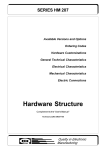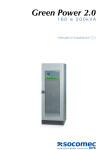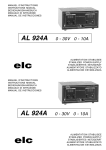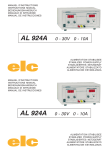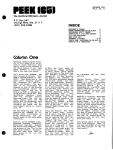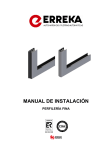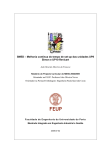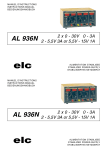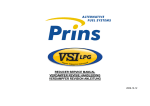Download INSTALLATION MANUAL FOR DELPHYS MX and DELPHYS MX
Transcript
INSTALLATION MANUAL FOR DELPHYS MX and DELPHYS MX elite UNINTERRUPTIBLE POWER SYSTEMS UPS/NTA GB/DELMX_INS.D 08/03/2005 Certificate of Warranty The warranty conditions are stipulated in the sales contract, if not the following points shall apply. The manufacturer exclusively guarantees his own products against any defect in construction or operation arising from faulty design, materials or workmanship according to the conditions set down below. The manufacturer, at his discretion, is entitled to adapt his product in order to comply with the warranty or replace the faulty parts. The manufacturer’s warranty does not apply in the following cases: - Defects arising either from designs or parts imposed or supplied by the Purchaser. - Failure due to fortuitous circumstances or force majeure. - Replacements or repairs resulting from normal wear of units and machinery, - Damage or injuries caused by negligence, lack of inspection or maintenance, or improper use of the products. The period of validity of the warranty may never exceed 12 months after delivery. Replacements, repairs or modifications of parts during the warranty period cannot extend the duration of the warranty. For these stipulations to be valid, the Purchaser must, within a maximum of 8 days beyond which the warranty lapses, expressly inform the Manufacturer of the faulty design, or the material or manufacturing defect, stating in detail the grounds for his complaint. Defective parts replaced free of charge by the Manufacturer are to be put at his disposal, so that he may become the sole owner. The warranty legally ceases if the Purchaser has, of his own initiative, undertaken modifications or repairs on the Manufacturer’s products without the written consent of the latter. The Manufacturer’s liability is limited to the obligations as defined herein (repair or replacement), all other items of damage being formally excluded. The Purchaser is liable for taxes or duties of any kind in compliance with either the European regulations, or those of the country of import or transit. UPS/NTA GB/DELMX_INS.D page 1/28 FOREWORD We thank you for the trust you have in Socomec Sicon’s Uninterruptible Power Systems. This equipment is fitted with up to date technology. Rectifier and inverter subsets are provided with power semiconductors (IGBT) including a digital micro-controller. Our equipment complies with standard CEI EN 62040-2 referring to Uninterruptible Power Systems (UPS). CAUTION : “This is a product for restricted sales distribution to informed partners. Installation restrictions or additional measures may be needed to prevent disturbances”. SAFETY REQUIREMENTS Using conditions: Do read carefully this manual and comply with the safety notes mentioned before using the UPS. Whatever the repairs, they must be made only by authorised staff, who have been suitably trained. It is recommended that the ambient temperature and the humidity of the UPS environment are maintained below the values specified by the manufacturer. This equipment meets the requirements of the European directives applied to this product. As a consequence it is labelled as follows: REGULATIONS CONCERNED WITH ENVIRONMENTAL ISSUES Recycling of electrical products and equipment. Provision is made in European countries to break up and recycle materials making up the system. The various components must be disposed of in accordance with the legal provisions in force in the country where the system is installed. Battery wastes Used batteries are considered as toxic wastes. It is therefore essential to entrust them solely and exclusively to firms specialised in their recycling. They can not be treated with other industrial or household wastes, as set out in local regulations in force. UPS/NTA GB/DELMX_INS.D page 2 CONTENTS 1. GENERAL ............................................................................................................................................................5 2. SAFETY NOTES ..................................................................................................................................................5 3. GENERAL PACKAGING AND STORAGE CONDITIONS...................................................................................6 3.1. UPS packaging..............................................................................................................................................6 3.2. Battery packaging..........................................................................................................................................6 4. GENERAL RECOMMENDATIONS FOR INSTALLATION ..................................................................................6 4.1. Premises and location ...................................................................................................................................6 4.2. Constraint for cabinet location.......................................................................................................................7 4.3. Installation on a raised floor ..........................................................................................................................7 4.4. Ventilation and air conditioning constraints...................................................................................................8 5. HEAT LOSS AND VENTILATION ........................................................................................................................8 5.1. General rules for cable installation on tray....................................................................................................9 6. HANDLING FROM ABOVE................................................................................................................................10 7. HANDLING FROM UNDERNEATH ...................................................................................................................11 8. INSTALLATION ..................................................................................................................................................12 8.1. Cabinet positioning......................................................................................................................................12 8.2. Layout of power connections.......................................................................................................................12 9. GENERAL RULES FOR CABINET ASSEMBLING ...........................................................................................13 9.1. Inverter cabinets ..........................................................................................................................................13 9.2. Battery cabinets...........................................................................................................................................14 9.3. Adjusting the fastening rod of Cadrys Delta cabinets .................................................................................14 10. DIMENSIONS AND WEIGHTS ..........................................................................................................................15 10.1. UPS cabinets and modular units (for parallel system). .............................................................................15 10.2. Central bypass cabinet..............................................................................................................................15 10.3. Bypass isolating transformer (for linear loads)..........................................................................................15 11. LOCATION AND DIMENSIONS OF TERMINALS.............................................................................................16 11.1. Separated rectifier and bypass inputs.......................................................................................................16 11.2. Common rectifier and bypass input...........................................................................................................16 11.3. Connection to a neutral system of TNC type ............................................................................................17 11.4. Terminals for unit inputs on bypass cabinet..............................................................................................17 11.5. Terminals for mains input/load output on the bypass cabinet...................................................................17 12. DESCRIPTION OF POSSIBLE UPS CONFIGURATIONS................................................................................18 13. EXTERNAL CONNECTIONS.............................................................................................................................19 13.1. Grounding precautions ..............................................................................................................................19 13.2. Connecting earth cables............................................................................................................................19 13.3. Earth cable cross-section ..........................................................................................................................19 13.4. Leakage current (rating of the differential protection) ...............................................................................19 13.5. Neutral cable cross-section .......................................................................................................................19 UPS/NTA GB/DELMX_INS.D page 3 14. VALUES OF CURRENTS FOR CABLE SIZING................................................................................................20 14.1. Input currents for a rectifier with a 50A charger (standard back up time) .................................................20 14.2. Input currents for a rectifier with a 100A charger (expanded back up time) .............................................20 14.3. Battery currents .........................................................................................................................................20 14.4. Bypass current (or output current to the load)...........................................................................................21 15. SIZING OF CIRCUIT BREAKERS .....................................................................................................................21 15.1. Rectifier input circuit breaker.....................................................................................................................21 15.2. Circuit breaker on bypass input.................................................................................................................22 15.3. Circuit breaker on a common rectifier and bypass input...........................................................................22 16. OPTIONAL COM - SLOT FRAME FOR EXTERNAL COMMUNICATION ........................................................23 16.1. Layout of the COM-SLOT frame ...............................................................................................................23 16.2. STANDARD and ADC PCBs (UIO – 0x) ...................................................................................................24 16.2.1. Layout...........................................................................................................................................24 16.2.2. Description of input and output data ............................................................................................24 16.2.3. Description of terminals................................................................................................................24 16.3. Serial connection PCB (USL – 0x) ............................................................................................................25 16.3.1. Layout...........................................................................................................................................25 16.3.2. Description of connections ...........................................................................................................25 17. EMERGENCY STOP (ESD)...............................................................................................................................25 18. AUTOMATIC OPENING OF BATTERY PROTECTION Q20 ............................................................................26 18.1. Generator set operation ............................................................................................................................26 19. REMOVING AND ASSEMBLING TRANSFORMERS IN THE UPS ..................................................................27 Lexicon : UPS Module CIM : Uninterruptible Power Systems : set comprising a rectifier, a battery and an inverter in a parallel system : Consulting, Inspection and Maintenance Department. UPS/NTA GB/DELMX_INS.D page 4 1. GENERAL This manual gives important information as regards safety, handling and connection of DELPHYS MX and DELPHYS MX elite UPS’s. 2. SAFETY NOTES For the safety of personnel and equipment, do read very carefully this instruction manual. WARNING Take all precautions when handling the cabinets or the various components of the system, such as batteries. CAUTION Whatever the connections or the using and maintenance operations, they must be exclusively performed by authorised staff, who have been trained accordingly. CAUTION EMI filters inside the UPS induce high leakage currents. As a consequence, it is imperative to connect earth cables before any mains connection. CAUTION UPS/NTA GB/DELMX_INS.D The equipment can only be switched on or used if the following conditions are fulfilled : - electrical connections comply with the regulation in force (earth bonding, appropriate protections and cross-section of cables) - all means to comply with the protection index of the system are in place, such as side panels, doors, glands, shields or whatever...). page 5 3. GENERAL PACKAGING AND STORAGE CONDITIONS 3.1. UPS packaging Packaging category Packing Applications Standard BULLPACK packaging Equipment is protected by two layers of Road transport for domestic cellular plastic (or three for non-domestic market or forwarding to destinations) fastened with scotch tape. neighbouring countries. CPA-type packaging (cardboard pallet) At customer’s request and in addition to the BULLPACK two-layer protection, extra transport for UE packaging consists of fastening the equipment Road to a wooden pallet and to protect it with a countries or air freight for cardboard fixed to the pallet. worldwide destinations. Under specific request, a corrosion proofing barrier can replace the Bullpack protection Packaging SEI 4C (called NEFAB) The packaging consists of crates with closed joints and physical-chemical protection. The corrosion protection is guaranteed by a VCI Sea transport for equipment wrapping (Vapour and Corrosion Inhibitor), that might be stored for an resistant to considerable difference in extended period of time. temperature and by the addition of desiccant bags. Unless otherwise requested, the storage period is limited to 12 months. 3.2. Battery packaging Batteries are delivered on pallets, in pallets-cases or mounted in cabinets. Avoid striking battery cells and connection terminals. 4. GENERAL RECOMMENDATIONS FOR INSTALLATION 4.1. Premises and location The proposed location for the UPS should be as follows: - there should be no obstacle lying on the floor, the installation of cables or conduits should be completed, the room must be large enough, it should be dry, clean and dust-free (a dust preventing paint covering is required in a cement room), the local should be free of flammable vapour or corrosive smoke, ventilation should be sufficient to ensure a constant temperature to the UPS and to the batteries. The recommended ambient temperature is between 15°C and 25°C UPS/NTA GB/DELMX_INS.D page 6 4.2. Constraint for cabinet location To ensure the proper ventilation of the equipment, always leave a minimum clear distance of 700 mm between the top of the cabinet and the ceiling. No clearance at the back of the cabinet is required. Hence : - Two units can be placed back to back - The unit can be placed against a wall. When the cabinets are placed face to face, leave a clearance of 2,30 m to give free way1 when the doors of the cabinets are opened. 0,80 m 0,70 m 0,80 m Top view of two face to face UPS’s 4.3. Installation on a raised floor For weight and space requirements, the UPS is installed on a specific base (Seek advice from the factory). Front face Inject fresh air under the cabinets, UPS Provide cut-outs in the raised floor for adequate ventilation to the front. Dimensions of the cut-outs : - length of UPS cabinet - width : 0,15 m minimum 1 Fresh air flow Fresh air flow Specifications as per standard IEC 60364 or NFC15100 UPS/NTA GB/DELMX_INS.D page 7 4.4. Ventilation and air conditioning constraints VENTILATION WRONG RIGHT WARM AIR WARM AIR COLD AIR COLD AIR AIR CONDITIONING WRONG RIGHT WARM AIR AIR CONDITIONER AIR CONDITIONER COLD AIR WARM AIR COLD AIR 5. HEAT LOSS AND VENTILATION The recommended ambient temperature is between 15 and 25°C. POWER (kVA) AIR FLOW (m3/h) 250 300 400 500 UPS/NTA GB/DELMX_INS.D 6140 6140 6140 6140 HEAT LOSS at Pn (kW) MX 14 16 19,7 - MX elite 16 19 24 31 HEAT LOSS at Pn (kcal/h) MX 12500 13370 17000 - MX elite 13770 16350 20700 26680 page 8 5.1. General rules for cable installation on tray Power cables Connection to the system cabinets: All metallic cable trays must be grounded. Divide the power cables into groups, according to the different circuits : - mains input, - battery input, - connections to each unit, - load output. Gather all poles of a power circuit in the same group : - poles + and - for the battery, - 3 phases + PE for a three-phase distribution (rectifier supply), - 3 phases + neutral + PE for the bypass supply, or the distribution, - 3 phases + PE for the bypass supply through an isolation transformer. CORRECT INSTALLATION WITH PARTITIONING ADMISSIBLE INSTALLATION WITHOUT PARTITIONING Risk of electromagnetic disturbances between battery and load cables 10 cm mini. 10 cm mini. CAUTION : WRONG All metallic cable trays -either fixed to the wall or in a raised floor- must be grounded and connected to the corresponding cabinets. Control cables connections: and low power This category includes : - the connections between the cabinets and each unit, - the alarm signals, - the remote control connection, - the connections to the BMS (Building Management System), - the emergency stop, - the connection to the generator set. Do not place power and control cables together in the same tray and same group. CAUTION : CORRECT INSTALLATION WITH PARTITIONING ADMISSIBLE INSTALLATION WITHOUT PARTITIONING OF THE CONTROL CABLES 10 cm mini. 10 cm mini. 10 cm mini. WRONG ALL METALLIC CABLE TRAYS, MUST BE GROUNDED AND CONNECTED TO THE CORRESPONDING CABINETS. UPS/NTA GB/DELMX_INS.D page 9 6. HANDLING FROM ABOVE For weight and dimensions of the UPS, please see section 10. Please, take into account the instructions provided for handling, so as to avoid damage to the equipment. THE USE OF STRAPS IS PROHIBITED IMPORTANT: L =2 m m in i THE CABINETS MUST BE KEPT IN AN UPRIGHT POSITION WHEN SHIPPED OR HANDLED. HANDLING BY USING SLINGS Slings can be used, provided that they are ≥ 2 m. HANDLING BY USING A LIFTING BEAM If the height under ceiling does not allow the use of slings, it is preferable to use a lifting beam. NOTE : eye screws of M16 type with 35-mm inner diameter are supplied on request. Remove the screw or plastic part protecting the thread and insert the eye screws. In order to meet the protection index specified, do no forget to replace the screws or plastic parts after removing the eye screws. UPS/NTA GB/DELMX_INS.D page 10 7. HANDLING FROM UNDERNEATH Remove the grilles on the front and rear of the cabinet and introduce the fork under the unit. Caution : the load can be unbalanced (Please see below). Mind the position of the gravity centre for each UPS range when using a lifting truck. m 0m 81 Gravity centre for DELPHYS MX G 500m m 91 4m 723mm G 515m m 640mm Gravity centre for DELPHYS MX elite m Lateral handling is also possible, provided that the bottom side panels are removed. The lifting truck must have long fork. Handling from the left Handling from the right Note : the fork should be at least 1600 mm long UPS/NTA GB/DELMX_INS.D page 11 8. INSTALLATION 8.1. Cabinet positioning To make transport and handling easier, the system is separated into cabinets (or cabinet sets). 3 2 1 4 The 'Y' symbol on the front face indicates the separation points between the cabinets. The individual cabinet position should correspond with sequence / numbers indicated on the front view of the system. (The number of each cabinet is indicated on the right top corner on the inside of the door). Note : reference should be made to the technical details in the drawing file. 8.2. Layout of power connections When assembling the cabinets, the "" symbols mentioned on the basic scheme indicate the power connections to be achieved. PE X10 X20 X40 X50 : earth bonding, : rectifier mains input, : battery input, : bypass mains input, : output to the load. X40 X10 Battery cabinet Delphys MX For connection arrangements, please see section 11. Note : reference should be made to the technical details of the drawing file. Q20 PE X20 X50 Note : For dimensions and designation of terminals and terminations, please see section 11. UPS/NTA GB/DELMX_INS.D page 12 9. GENERAL RULES FOR CABINET ASSEMBLING 9.1. Inverter cabinets BETWEEN EACH OTHERS Use tensilock screws - supplied by the manufacturer - to assemble the different cabinets. These are 'welded structure-type cabinets', meeting all requirements as regards electromagnetic compatibility. The tensilock screws bite into the paint and guarantee electric contact between the frame and the different cabinets. They also guarantee equipotential grounding. NOTE : if cabinets are placed against a wall, screw fixings located at the rear are not accessible; as a result the screw on the top of the rear panel will be the only one to be fixed. ON A RAISED FLOOR (or directly on the floor) Each foot of the cabinet needs to be linked up to the metallic mesh network (if the cabinet is on a raised floor) or to have direct earth bonding (if the cabinet is directly positioned on the floor) by using short links with a cross-section ≥ 35 mm². Use braidings to connect all the metallic feet of the raised floor and guarantee equipotential cabling. A = fixing to the floor (hole ∅ 13), B = screw THM 14 for level adjustment, C = fixing of braidings, D = fixing of the grille C D A B SEPARATED CABINETS Avoid spaces between cabinets. Connect the cabinets to each other by using a conductor with a crosssection ≥ 35 mm² and not exceeding a 20-meter length. An accessible and grounded metallic mesh network can also be a solution if every cabinet is connected to this network (see above). UPS/NTA GB/DELMX_INS.D page 13 9.2. Battery cabinets ELECTRICAL SAFETY For safety reasons during transports and handling, batteries are disconnected at the level of each rack (or by sections not exceeding 150 V). Take all necessary precautions when reconnecting the cables. MECANICAL SAFETY For batteries on racks or in cabinets, the cabinet must be fixed to the floor to prevent it from falling over. Each cabinet is fitted with pre-drilled feet - See dimensions below. CABINET FIXING TO THE FLOOR FEET OF BATTERY CABINET Each foot has a floor fixing hole (labelled A : ∅ 13) and a welded nut for level adjusting (labelled B : screw THM12 not supplied). A B CAUTION : When the battery cabinet is installed, cut and remove the plastic fastening of battery cells in order to release the safety valve. ELECTRICAL CONNECTIONS CAUTION Connection must be performed by authorised staff, which have been previously trained. Connections to be performed are : - grounding of battery cabinet, - polarities + and – to the inverter, - between battery sections and/or between shelves. 9.3. Adjusting the fastening rod of Cadrys Delta cabinets Adjust part marked "A" to your needs in order to adapt the insert of the fastening rod. UPS/NTA GB/DELMX_INS.D A page 14 10. DIMENSIONS AND WEIGHTS The packed weight of each item is shown: - with paint on wooden crates, - with indelible felt pen on cellular plastics if standard packing is used. 10.1. UPS cabinets and modular units (for parallel system). POWER (kVA) WEIGHT MX range (kg) WEIGHT MX elite range (kg) 250 3-ph 300 3-ph 400 3-ph 500 3-ph 1650 2210 1700 2260 1800 2450 2900 1600 DEPTH (mm) - floor requirement 950 - Overall dimensions with door handle 995 - door, handle and rear panel excluded HEIGHT (mm) 945 1930 10.2. Central bypass cabinet POWER (kVA) WEIGHT (kg) WIDTH (mm) DEPTH (mm) - floor requirement 500 to 800 3-ph 900 to 1200 3-ph 1500 to 2000 3-ph 420 1000 600 1300 2000 3200 815 1200 - Overall dimensions with door handle 845 1220 - door, handle and rear panel excluded HEIGHT (mm) 800 1175 1930 10.3. Bypass isolating transformer (for linear loads) Note: for supplying non-linear loads, please seek advice from the factory. POWER (kVA) WEIGHT (kg) WIDTH (mm) DEPTH (mm) - floor requirement ∗ 250 and 300 3-ph 400 3-ph 500 and 600 3-ph 980 1000 1500 1200 2000 1200 800 3-ph ∗ 1200 815 - Overall dimensions with door handle 845 - door, handle and rear panel excluded HEIGHT (mm) 800 1930 Depends on the type of equipment. UPS/NTA GB/DELMX_INS.D page 15 11. LOCATION AND DIMENSIONS OF TERMINALS 11.1. Separated rectifier and bypass inputs - PE : - X10 : - X40 : - X50 : Protection conductor Rectifier input Bypass input To the load Note: all terminations are in copper and perforated with 3 holes ∅13 for screws of M12 type. The maximum cross section is 3x300mm² in aluminium Q3 Q5 Q4 Q1 X20 + L1 L1 X20 - 7 L2 L1 L3 L2 X10 L2 L3 N 5 4 N 3 2 X50 X40 PE 6 L3 1 F82 F83 11.2. Common rectifier and bypass input With a common rectifier and bypass input, a busbar is provided to make the connections between the rectifier input and the bypass input terminals. - PE : - X40 : - X50 : Protection conductor Common rectifier and bypass input To the load The maximum cross section is 3x300mm² in aluminium Q3 Q5 Q4 Note: all terminations are in copper and perforated with 3 holes ∅13 for screws of M12 type. Q1 X20 + L1 L1 7 L2 L3 X20 - L2 6 L3 4 X40 N X40 N 3 X50 2 1 PE UPS/NTA GB/DELMX_INS.D 5 F82 F83 page 16 11.3. Connection to a neutral system of TNC type Protection conductor Rectifier input Bypass input To the load Note: all terminations are in copper and perforated with 3 holes of ∅13 for screws of M12 type. The maximum cross section is 3x300mm² in aluminium Q1 PEN - PE : - X10 : - X40 : - X50 : X20 + X40 L2 X20 - L1 L2 L3 L1 L3 L1 L2 7 6 5 L3 4 X10 PEN X50 3 2 1 F82 F83 11.4. Terminals for unit inputs on bypass cabinet POWER (kVA) 600 to 800 3-ph 1200 3-ph UNIT INPUTS Dimensions of terminals X45 X45 Terminations in Cu, 3 holes ∅13, screw THM12 Terminations in Cu, 6 holes ∅13, screw THM12 11.5. Terminals for mains input/load output on the bypass cabinet POWER (kVA) 600 to 800 3-ph 1200 3-ph INPUT (X40) TO LOAD (X50) X40 and X50 X40 and X50 Dimensions of terminals Terminations in Cu, 3 holes ∅13, screw THM12 Terminations in Cu 2, 6 holes ∅13, screw THM12 Extension terminals (3 holes ∅13) are to be moved from X40 to X50 if cable input is from above. The maximum cross section is 3x300mm² in aluminium. 2 UPS/NTA GB/DELMX_INS.D page 17 12. DESCRIPTION OF POSSIBLE UPS CONFIGURATIONS X40 X10 STANDARD UPS WITH NON ISOLATED RECTIFIER X10 = RECTIFIER INPUT X20 = BATTERY CONNECTION X40 = BYPASS INPUT X50 = OUTPUT TO THE LOAD Q20 X20 X50 X40 X10 X500 STANDARD UPS WITH NON ISOLATED RECTIFIER AND BYPASS TRANSFORMER T500 X10 X20 X500 X50 = RECTIFIER INPUT = BATTERY CONNECTION = BYPASS INPUT = OUTPUT TO THE LOAD Q20 X20 X50 X40 X10 STANDARD UPS WITH ISOLATED RECTIFIER T10 ABC L10 ABC X10 = T10 ABC = L10 ABC = X20 = X40 = X50 = RECTIFIER INPUT primary transfo T13 secondary transfo T13 BATTERY CONNECTION BYPASS INPUT OUTPUT TO THE LOAD T13 Q20 X20 X50 X10 = T10 ABC = L10 ABC = X20 = X500 = X50 = RECTIFIER INPUT primary transfo T13 secondary transfo T13 BATTERY CONNECTION BYPASS INPUT OUTPUT TO THE LOAD X40 X10 STANDARD UPS WITH ISOLATED RECTIFIER AND BYPASS TRANSFORMER X500 T10 ABC L10 ABC T13 T500 Q20 X20 X50 UPS/NTA GB/DELMX_INS.D page 18 13. EXTERNAL CONNECTIONS External connections are: - grounding connection, - rectifier and bypass connections, - load output, - emergency stop and alarm transfers. 13.1. Grounding precautions UPS’s manufactured by SOCOMEC SICON UPS are designed for any grounding systems and are compatible with IT, TNS, TT neutral arrangements. When the neutral arrangement is of TNC type, the equipment must have a PEN conductor. In cases of different neutral systems between the utility and the load, a transformer must be installed at the bypass input to carry out isolation. 13.2. Connecting earth cables IMPORTANT : due to EMI filters*, there are "HIGH LEAKAGE CURRENTS". As a consequence, it is imperative to connect earth cables before mains cables. * EMI filters = protection against electromagnetic disturbances. 13.3. Earth cable cross-section The earth cable cross section should be equal to the phase cable cross-section. 13.4. Leakage current (rating of the differential protection) The minimum differential current recommended is 300 mA. 13.5. Neutral cable cross-section It is necessary to check: a) the minimum cross-section of the neutral cable must equal one of the phase conductors. It is recommended to double the neutral conductor cross-section for supplying nonlinear loads as soon as: Icrest per phase / I r.m.s. per phase > 2,2. b) the balancing of the loads across the three phases, c) the values that will trip the protective devices. UPS/NTA GB/DELMX_INS.D page 19 14. VALUES OF CURRENTS FOR CABLE SIZING NOTE : these values are only indicative for standard systems. 14.1. Input currents for a rectifier with a 50A charger (standard back up time) Operating conditions are as follows: Input/output power supply voltage 3x400V, The UPS is operating at rated power and batteries are recharging. POWER on UPS output (kVA) UPS MX Max. rectifier input current UPS MX elite Max. rectifier input current 250 kVA 3-phase 365A 365A 300 kVA 3-phase 435A 435A 400 kVA 3-phase 570A 570A 500 kVA 3-phase - 715A 14.2. Input currents for a rectifier with a 100A charger (expanded back up time) Operating conditions are as follows: Input/output power supply voltage 3x400V, The UPS is operating at rated power and batteries are recharging. POWER on UPS output (kVA) UPS MX Max. rectifier input current UPS MX elite Max. rectifier input current 250 kVA 3-phase 398 398A 300 kVA 3-phase 468 468A 400 kVA 3-phase 602 602A 500 kVA 3-phase - 755A 14.3. Battery currents at the end of the back up time The UPS is operating at rated power and batteries are recharging. ∗ UPS Power 250 kVA 300kVA 400kVA 500kVA Currents 721A∗ 865A* 1130A* 1276A* Maximum value before UPS shutdown UPS/NTA GB/DELMX_INS.D page 20 14.4. Bypass current (or output current to the load) Operating conditions are as follows: - input/output power supply voltage 3x400V, - The UPS is operating at rated power. UPS power 250 kVA 300kVA 400kVA 500kVA Current per phase 362A 435A 580A 722A Note: Rating of cables and protections upstream of the bypass shall take into account the following: - overloads caused by non-linear loads, - possible overloads admitted by the UPS i.e. 1,1In for 1h, 1,25In for 10min or 1,5In for 1min. 15. SIZING OF CIRCUIT BREAKERS 15.1. Rectifier input circuit breaker Values are only indicative as per the following conditions: - the rectifier and bypass input voltage is 3x400V with a cos phi = 0,8, - the length of cabling between the circuit breaker and the UPS is <10 metres. UPS type 250kVA 300kVA 400kVA 500kVA Charger 50A 400A 3p 630A 3p 630A 3p - Charger 100A 630A 3p 630A 3p 800A 3p - Charger 50A 400Av 3p 630A 3p 630A 3p 800A 3p Charger 100A 630A 3p 630A 3p 800A 3p 1000A 3p Charger 50A 630A 3p 630A 3p 630A 3p 800A 3p Charger 100A 630A 3p 630A 3p 800A 3p 1000 3p MX MX elite non isolated MX elite isolated Note 1: the admissible input voltage tolerance is +/-10% - the sizing of circuit breaker has therefore to be adjusted accordingly. UPS/NTA GB/DELMX_INS.D page 21 15.2. Circuit breaker on bypass input Values are only indicative as per the following conditions: - the rectifier and bypass input voltage is 3x400V with a cos phi = 0,8 on linear loads, - the length of cabling between the circuit breaker and the UPS is <10 metres. UPS power 250kVA 300kVA 400kVA 500kVA Circuit breaker on the bypass input 400A 4p 630A 4p 630A 4p 800A 4p Note 1: the admissible input voltage tolerance is +/-10% - the sizing of circuit breaker has therefore to be adjusted accordingly. Note 2: the protection on the bypass input is intended for cable protection and does not take into account the I2T of thyristors. 15.3. Circuit breaker on a common rectifier and bypass input Values are only indicative as per the following conditions: - the rectifier and bypass input voltage is 3x400V with a cos phi = 0,8 on linear loads, - the length of cabling between the circuit breaker and the UPS is <10 metres. UPS power 250kVA 300kVA 400kVA 500kVA General circuit breaker on the UPS input 630A 4p 630A 4p 800A 4p 1000A 4p Note: the admissible input voltage tolerance is +/-10% - the sizing of circuit breaker has therefore to be adjusted accordingly. UPS/NTA GB/DELMX_INS.D page 22 16. OPTIONAL COM - SLOT FRAME FOR EXTERNAL COMMUNICATION 16.1. Layout of the COM-SLOT frame PCB’s are gathered on a specific frame located in the bottom right corner of the UPS (See below). View of the communication frame Q3 Q5 Detailed view 7 6 5 4 L1 L1 L2 L3 N X40 L2 3 2 L3 1 N X50 F82 F83 FRAME including COMMUNICATION PCBs Seven slots identified from 1 to 7 can be used. Slot 1: Standard interface PCB is provided as a standard with 3 inputs and 4 outputs with defined data (See section 14.2.2). Slot 2, 3 and 4: These ADC PCBs are optional with 4 input and 3 output data that can be set as per customer’s requirements. Using 3 ADC PCBs in the respective slots allow to have up to 12 settable inputs and up to 9 settable outputs. Slots 5 and 6 : the following communication PCBs can be selected: - a series communication interface via an isolated RS232/RS485 connection using MODBUS/JBUS protocol - a NET VISION interface for connection to the Ethernet, Slot 7 : option intended for the MODEM PCB or remote mimic panel. (The remote mimic panel has to be forecasted in the order because it requires specific modification in the COM-SLOT). UPS/NTA GB/DELMX_INS.D page 23 16.2. STANDARD and ADC PCBs (UIO – 0x) 16.2.1. Layout 16.2.2. Description of input and output data Input data : - Emergency stop - Opening of battery connection - Emergency generator loop closing on terminations IN1- and IN1+*, loop closing on terminations IN2- and IN2+, loop closing on terminations IN3- and IN3+. * dual input to allow the transfer of alarms. Output data : - General Alarm - Servicing alarm - Battery operation - LOAD ON MAINS dry contacts, terminations C1 dry contacts, terminations C2 dry contacts, terminations C3 dry contacts, terminations C4 NO1 NO2 NO3 NO4 NC1* NC2* NC3* NC4* * C = Common ; NO = make contact ; NC = break contact. 16.2.3. Description of terminals The wire size capacity of screw terminals is between 0,5 and 1,5 mm2 The emergency stop has a dual input for the transfer of alarms. Breaking capacity : 8A/230V AC. XB1 C2 NO2 NC2 IN1- IN1+ IN3- IN3+ C3 NO3 NC3 2 OUT 1 UPS/NTA GB/DELMX_INS.D 3 OUT 4 C1 NO1 NC1 IN1- IN1+ IN2- IN2+ C4 NO4 NC4 page 24 16.3. Serial connection PCB (USL – 0x) 16.3.1. Layout 16.3.2. Description of connections RS232 XC2 : female DB9 standard connector of PC type. RS485 isolated XB1 : RTX+ and RTX- RS422 isolated XB1 : RTX+ for 'Transmit +' RTX- for 'Transmit –' RX+ RX- LEDs VL1 and VL3 provide information about the reception and transmission steps. LED VL2 indicates whether there is voltage or not. 17. EMERGENCY STOP (ESD) The UPS emergency stop causes: - the load to be shutdown - the rectifier and inverter to be shutdown while the battery remains connected. However, the battery connection can be made open on request, through the addition of a Mx coil, directly controlled by the emergency stop (Please, see following sections). Single UPS (Standard PCB) The emergency stop is carried out through the closing of the loop on terminations IN- and IN+. Dual input is provided to ensure the transfer of alarms. Opening of the loop can be set at commissioning. Modular systems Each unit is fitted with a COM SLOT frame including a standard PCB. The emergency stop can either control each unit separately or the whole system, provided that each loop is galvanically separated. UPS/NTA GB/DELMX_INS.D page 25 Central bypass systems The central bypass cabinet incorporates a COM-SLOT frame including a standard PCB. The emergency stop can control : - only the central bypass cabinet (standard PCB – terminations IN1- and IN1+), - the whole system, provided that galvanic isolation is carried out between each loop. 18. AUTOMATIC OPENING OF BATTERY PROTECTION Q20 Opening of Q20 is controlled through loop closing on terminations IN2- and IN2+ of the standard PCB. This option enables Q20 to be opened following an emergency shutdown or a slow discharge. Batt Q20 PE Battery cabinet/enclosure Connection inside the UPS MX STANDARD UIO01 PCB IN2- IN2+ 18.1. Generator set operation A so-called GENERATOR SET information allows the UPS to operate according to gen set conditions. The manufacturer can set three conditions for generator set operation, that is: a) output voltage of charger(s) adjusted to the off-load voltage of the batteries. In such a case, the corresponding input is on terminations IN3- and IN3+ of the standard PCB, b) desynchronisation of the inverter from the bypass mains and bypass locked, thus no transfer to the bypass mains is possible, Case of a modular system : each module has to be connected to terminations IN3- and IN3+ of the standard PCB, Case of a central bypass system : the input is in the central bypass cabinet and has to be connected to terminations IN3- and IN3+ of the standard PCB. This data is transmitted via the internal bus to each module, that can individually be adjusted to a different off-load voltage. c) function a) and function b) through contact combination. NOTE Without a specific request, the factory standard setting implies there is no action on the UPS when the generator set is operating. Configurations mentioned above, can be set at commissioning UPS/NTA GB/DELMX_INS.D page 26 19. REMOVING AND ASSEMBLING TRANSFORMERS IN THE UPS Comply with the following operations: Loosen the 30 screws maintaining the 2 panels at the rear of the equipment. Rear view : - N° 1 → input transformer of the UPS - N° 2 → output transformer of the UPS For the DELPHYS MX range, only transformer N° 2 is provided. Loosen the 6 screws THM12 marked A, B & C allowing the bar to be removed. Remove the dust filters (if any) by pulling them out horizontally. Undo the electrical connections of the transformer(s). UPS/NTA GB/DELMX_INS.D page 27 E There are 4 fixing screws for each transformer : - D 2 screws THM12 for horizontal fixing (D & E). 2 screws THM12 for vertical fixing (F & G). G F General view detailing the way transformers are fixed. - Transformer 2 : screws D & E for horizontal fixing, screws F & G for vertical fixing. - Transformer 1 : screws H & J for horizontal fixing, screws K & L for vertical fixing. Fork of the handling device must be placed under the transformer for extracting it. For assembling, proceed in the reverse order. CAUTION : the grille below the UPS must be repositioned at the end of the process because it is also used as an electromagnetic compatibility shield. UPS/NTA GB/DELMX_INS.D page 28





























